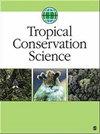巴西帕拉伊巴州农民农业生态系统的土壤质量指标
IF 1.6
4区 环境科学与生态学
Q2 BIODIVERSITY CONSERVATION
引用次数: 0
摘要
背景与研究目的:土壤质量(SQ)是农民耕作制度(PFS)可持续性的基础。我们假设不同的土地利用方式会改变土壤质量,通过测定土壤质量指数(SQI)来分析土壤质量的变化。研究方法在索拉奈亚市(A)、卡塞伦盖市(B)和塞拉利亚市(C)的五个农民农业生态系统子系统中采集了 0-20 厘米层的土壤样本。采用非线性评分法计算 SQI,同时利用所有数据(体积和颗粒密度、总孔隙度、颗粒大小、pH 值、宏量营养元素和土壤有机碳)进行主成分分析,以确定最小数据集 (MDS)。结果:由可用磷、Ca+2、Al+3、砂、淤泥、H+Al、碱饱和度(BS%)和铝饱和度(AS%)组成的最小数据集表明,这些参数可作为农民农业生态系统的土壤质量评估指标。砂和淤泥与成土过程和母质有关,其余指标则反映了管理方法。从森林到耕地的土地转换降低了农业生态系统 A(Arenosol)和 B(Luvisol)的养分可用性和土壤有机质,提高了农业生态系统 C(Lixisol)的阳离子交换能力。结论所有农业生态系统的 SQI 值都很低,这表明有必要在所研究的农业子系统中扩大保护措施,尤其是在增加土壤有机质方面。我们的研究结果有助于改善土壤的使用和管理以及对农民耕作的脆弱性评估,这是农业生态系统可持续发展的基本要求。对自然保护的影响:我们的研究结果还表明,农林业实践可以显著提高土壤质量和土壤固碳能力,是在容易出现退化的地区保持有机质的可行选择。本文章由计算机程序翻译,如有差异,请以英文原文为准。
Soil Quality Indicators in Peasant Agroecosystems in Paraíba State, Brazil
Background and Research Aims: Soil quality (SQ) is the basis for the Sustainability of Peasant Farming Systems (PFS). We hypothesized that different land uses modify soil quality through changes that can be analyzed by determining the Soil Quality Index (SQI). Methods: Soil samples were collected from the 0-20 cm layer in five subsystems of peasant agroecosystems located in the municipalities of Solânea (A), Casserengue (B), and Serraria (C). SQI was calculated using non-linear scoring, while a principal component analysis was performed using all data (bulk and particle density, total porosity, particle size, pH, macronutrients, and soil organic carbon) to determine a Minimum Data Set (MDS). Results: The MDS composed of P available, Ca+2, Al+3, sand, silt, H+Al, base saturation (BS%), and the aluminum saturation (AS%) indicate that these parameters can serve as indicators for soil quality assessment in peasant agroecosystems. Sand and silt are related to pedogenic processes and parent material, while the remaining indicators reflect management practices. Land conversion from forest to cropland decreased nutrient availability and soil organic matter in agroecosystems A (Arenosol) and B (Luvisol) and increased the cation exchange capacity in agroecosystem C (Lixisol). Conclusions: All agroecosystems showed low SQI values, highlighting the need to expand conservation practices in the studied agricultural subsystems, especially regarding the increase of soil organic matter. Our results contribute to improving the use and management of soils and the vulnerability assessment in peasant farming, an essential requirement for the sustainability of agroecosystems. Implications for Conservation: Our results also demonstrated that agroforestry practices can significantly increase soil quality and soil carbon sequestration, a viable alternative for maintaining organic matter in areas susceptible to degradation.
求助全文
通过发布文献求助,成功后即可免费获取论文全文。
去求助
来源期刊

Tropical Conservation Science
BIODIVERSITY CONSERVATION-
CiteScore
3.60
自引率
5.90%
发文量
16
审稿时长
>12 weeks
期刊介绍:
Tropical Conservation Science is a peer-reviewed, open access journal that publishes original research papers and state-of-the-art reviews of broad interest to the field of conservation of tropical forests and of other tropical ecosystems.
 求助内容:
求助内容: 应助结果提醒方式:
应助结果提醒方式:


